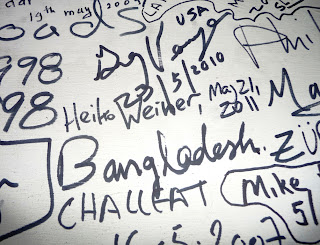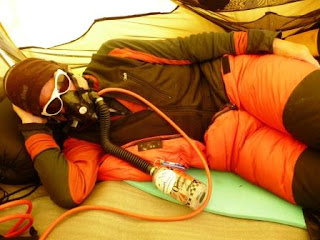Heiko's answers to the interview questions condensed in a write up:
At 11:30 am on May 29, 1953 Tenzing Norgay and Edmund Hillary stood on the 29,035 ft summit of Mt. Everest, finally succeeding in a more than 30 yearlong quest for the highest point on earth. The first ascent of the world’s highest mountain still remains one of the defining moments of human exploration.
Today, some 58 years later Mt. Everest still captures the imaginations of many and has not lost any of the appeal. The mountain is often described as “the 3rd pole” or “one of the ends of the earth” with at elevation of 29,035 ft equal to the cruising altitude of an airliner. Statistics show that of the roughly 11,000 people who have attempted to climb the mountain since the historic first ascent, 2,972 have been successful, representing an average rate of 29%. While the accessibility to the peak has certainly improved over the years, objective dangers have largely remained the same, a fact that is illustrated by an average of 5 fatalities per season totaling about 207 fatalities (about 2 %). Two major ascent routes are currently in use, one from the north in Tibet and the other from the South in Nepal. I chose the route of the 1953 ascent (the southern approach) from Nepal which remains the more popular today.
The dream to climb Mt. Everest developed naturally over the more than 18 years I spent climbing in different parts of the world. During that time I climbed in North and South America, Alaska, and the European Alps on mountains including Aconcagua (Argentina), Denali (Alaska), Sajama (Bolivia) and Orizaba (Mexico). I have always preferred - and still do - alpine over rock climbing, and have found great satisfaction with being out in the mountains during the winter months. The alpine environment is quite challenging, the climbs often involve long approaches in snow or inclement weather. One needs to be comfortable with winter camping and possess one of the most important requirements for an alpine climber: short memory, so that some of the hard and arduous hours can be easily forgotten over just a cup of hot tea at the end of a long day…
Climbing Mt. Everest is an enormous commitment, both physically, and financially. The inherent dangers are obvious, and the fact that no season on Everest passes without fatalities is something one needs to consider very seriously. The average expedition takes about two months, a major time commitment for both the actual expedition and also the required amount of training. In preparation for the Everest expedition, I spent about two years with serious conditioning, two or more hours / day, for an average of six days per week. That included several long practice climbs in Colorado, and a trip to Bolivia where I climbed Sajama (20,500 ft) and several other peaks in the region.
An expedition to the world’s biggest mountain is a complex undertaking, and there are challenges on many levels. The trail from Lukla to Everest base camp is about 40 miles long, a rough path that leads up to 17,500 ft and to the base of the Khumbu ice fall. Besides the obvious physical requirements, the debilitating effects of the increasing altitude, and dealing with food and water related illnesses present major issues. Once base camp is reached, more than four weeks are spent with acclimatization during which climbing proceeds in several stages up to an elevation of about 24,000 ft. Continuing inclement weather, wind and snow can make for a difficult time even at base camp. Staying healthy is critical and the enduring misery of being uncomfortable over many weeks is mentally challenging and requires some major perseverance. With ever changing conditions, the actual climbing can be hard and demanding. We often climbed anywhere between 5 – 8 hrs in steep and sometimes exposed terrain. Above 28,000 ft, the oxygen level is about 1/3 of that at sea level. Even with the use of supplemental oxygen there is only limited time during which body and mind continue to deteriorate. The final climb from camp four (26,000 ft) to the summit (29,035 ft) and back down to the relative safety of camp two (22,000 ft) took more than 22 hrs and was most certainly one of the hardest things I have ever done.
There are many factors that can effect the chances for a summit bid. Windows with favorable conditions are short, and things like wind, weather and snow conditions are outside of our control. As a result, a large percentage of the climbers are actual on the mountain for the second, sometimes third or even more times, hoping to be able to beat the odds this time around. For having succeeded with the first attempt I consider myself extremely fortunate, and also very lucky that I was able to return from the mountain without a lasting condition or debilitating injury.
Having stood on top of Mt. Everest certainly does not mean that I will now stop climbing altogether. There are many more mountains that are of interest for a variety of reasons and there are plenty of other destinations that are equally unique. For example, traveling to the Antarctica is also something I have always been interested in.
Preparing for demanding expeditions to remote locations such as Mt. Everest require long time commitments, discipline, and a life style that prepares body and mind equally well. Over the years I have found that this has definitely effected how I approach life in general and it has helped me to keep a positive


































